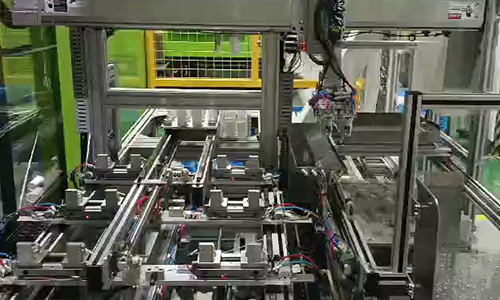
CES2025 is an annual technology event that can be called a "barometer" of technology trends. The world's top technology companies gather here to showcase cutting-edge and innovative products and technologies, leading the future development of technology. Smart homes, wearable devices, autonomous driving, artificial intelligence and many other fields are brilliant, and many giants have unveiled their "king bomb" products. So, what cutting-edge technology products are worth paying attention to?
Is this the new era of humanoid robots?
The number of domestic heavyweight players continues to increase
Many domestic companies brought robots to the CES exhibition, and "Made in China" humanoid robots and robot dogs shined. These humanoid robots can walk and run, can talk to people fluently, and can also organize clothes, pick up goods, and change light bulbs, turning the plots of science fiction movies into reality.
Beijing Galaxy General brought its embodied large-scale model robot GalbotG1 to the show. Reporters learned that Galaxy General built a 24-hour unattended convenience store scene on site. Visitors can experience the convenient service of picking up goods in the convenience store and completing the entire delivery process by simulating orders through iPads. In addition, GalbotG1 can also accurately perform grasping tasks under bright, extremely dark, and even drastically changing lighting conditions. It is reported that GalbotG1 has realized unattended drug management in the smart pharmacy project in cooperation with Meituan, and has been applied in multiple industrial scenarios.
The "Chengdu Man" "UltraMagnus" brought by Ajiaxi Intelligent Technology and Qualcomm is very powerful. As the world's first large multi-mode model based entirely on Qualcomm SoC, it can autonomously identify and actively greet visitors, accurately understand the needs and intentions of visitors, interact with visitors fluently by voice, and recognize different types of objects to achieve complex operations such as grasping and delivery. Industry insiders commented that "UltraMagnus" has achieved intelligent control and interaction completely on the terminal side, and is a rare full-end AI humanoid robot solution in the industry.
Lingbao CASBOT01 bipedal humanoid robot performs well in sports. It can not only stand on two feet, walk steadily, run, jump, etc., but also complete tasks such as tidying clothes and changing light bulbs. UnitreeG1 robot of Yushu Technology can perform actions such as "standing up", trotting, waving, etc., and can also perform more practical activities, such as smashing walnuts, flipping pots, welding, etc. Its four-legged robot dog can stably go up and down stairs, and the four-wheeled robot dog can perform handstands, showing the application potential of multiple scenarios.
The humanoid robot exhibition area at CES2025 was unprecedentedly grand. It can be seen that the humanoid robot industry will accelerate its development in 2024, cutting-edge technologies will continue to emerge, and the integration of humanoid robots and AI will become an important force for productivity transformation. According to the Gaogong Robot Industry Research Institute (GGI), the global humanoid robot market size will be approximately US$1.017 billion in 2024 and is expected to reach US$15 billion by 2030, with a compound annual growth rate of more than 56% from 2024 to 2030.
At CES2025, Nvidia founder Huang Renxun delivered a speech on topics such as AI, robots, and autonomous driving. He said that artificial intelligence is developing at an astonishing speed, from the most advanced perceptual AI (understanding images, text, and sounds) to generative AI (creating text, images, and sounds), and is now entering the era of physical AI, that is, AI that can run, reason, plan, and act.
Real-time image recognition and capture, invisible screens…
Multiple companies release AI smart glasses
Thunder Technology, which participated in CES for the first time, not only displayed its star products such as gaming laptops, e-sports monitors, desktops and e-sports peripherals, but also officially announced its entry into the field of smart glasses and will release three new smart glasses based on different technical principles.
Thunderbird Innovation and TCL jointly launched the AI photography glasses Thunderbird V3, which uses the first-generation Snapdragon AR1 flagship chip to achieve real-time image recognition and capture, without the need to operate complex mechanical parts. The average AI response speed of Thunderbird V3 is 1.3s, and the recognition accuracy rate is 98%, which greatly enhances the interactive experience.
Halliday smart glasses under Xianshun Technology also became popular during CES. It is a smart wearable glasses weighing 35 grams. People familiar with the matter revealed that the product is inlaid with a micro near-eye display module DigiWindow, which is located on the inside of the frame. There is a small display screen showing simple letters and images in the upper right corner of the user's field of view, showing information that only the user can see. In addition to the feature of invisible screen, Halliday uses active AI technology to analyze conversations in real time and provide answers on the spot. After connecting to a mobile phone with Bluetooth, the glasses can support real-time translation in up to 40 languages, as well as real-time navigation, voice-to-text and other functions. It is worth noting that this smart glasses can be fully charged in 1 hour and can be used for 12 hours.
Another Chinese company, XREAL, has also attracted much attention, launching its XREALOne/XREALOnePro AR glasses. Its self-developed XREALX1 spatial computing chip is the official "biggest update", which greatly improves the display capabilities of AR glasses. The so-called 3DoF means that when the user wears glasses, the displayed window will hover at a certain position in space and will not move with the movement of the head, thereby providing a more stable and natural picture display and avoiding continuous obstruction of the user's line of sight. According to the official preheating video, XREALOne's 3DoF hovering capability is very stable. Even if it is vibrated or shaken, the display image projected by the glasses remains still.
It is worth noting that many manufacturers such as Rokid, Gudong Technology, Snap, Meta, Baidu, and Thunderbird Innovation have recently released smart glasses-related products. Technology giants such as Samsung and Huawei are also actively deploying AI glasses-related projects. It is generally speculated in the industry that the era when glasses become the "next generation computing platform" may be coming. Industry insiders said that although the upsurge in the field of AI glasses was set off by Meta, domestic manufacturers are still the most active in responding. The technical composition of AI glasses is relatively clear, but clarity does not mean simplicity. Module miniaturization is still an important direction. If you want to truly provide a good AI glasses experience, there are considerable challenges in hardware, software, and algorithm levels. Hu Yuning, a reporter from Huashang Daily Dafeng News






 Release time:2025-01-17
Release time:2025-01-17
 Reading:77
Reading:77
 Back to list
Back to list